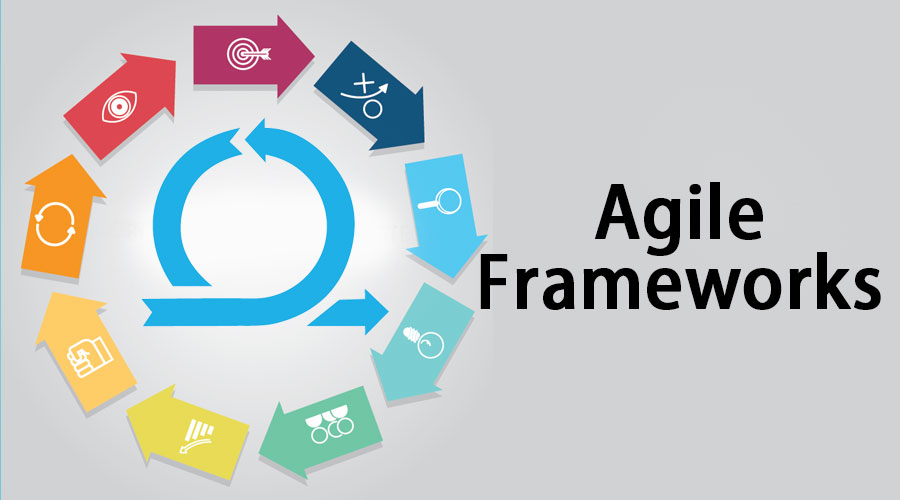Agile Software development cycle (ADLC)
The Agile software development cycle, often referred to as the Agile Development Life Cycle (ADLC), follows an iterative and incremental approach to software development. Here are the key stages within the Agile software development cycle:
- Conceptualization:
- Ideation: Generating ideas for the project or product.
- Defining Goals: Clearly outlining the project’s objectives and expected outcomes.
- Planning:
- Product Backlog: Creating and prioritizing a list of features, enhancements, and tasks.
- Release Planning: Determining the scope and timeline for iterations (sprints).
- Execution (Sprint Cycle):
- Sprint Planning: Selecting tasks from the product backlog for the upcoming sprint.
- Daily Stand-ups: Brief meetings for progress updates and issue resolution.
- Development: Implementing features and functionalities.
- Continuous Integration: Merging and testing code frequently.
- Review and Feedback: Sprint review and ssretrospective.
- Delivery:
- Incremental Delivery: Releasing potentially shippable product increments at the end of each iteration.
- Deployment: Deploying the completed features or increments to production if applicable.
- Feedback and Iteration:
- Gathering Feedback: Collecting input from stakeholders, end-users, and team members.
- Adjustments and Refinement: Using feedback to make adjustments, update priorities, and refine the product backlog for future iterations.
- Closure:
- Project Review: Evaluating the project’s success against the defined goals.
- Documentation: Documenting lessons learned, best practices, and any essential information for future projects.
- Celebration: Acknowledging and celebrating team achievements.
Manual or Automation which testing is more important in Agile Development
In Agile development, both manual testing and automation testing play important roles, and the choice between them depends on various factors. Here’s a breakdown of when each type of testing is commonly used in Agile:
Manual Testing:
- Exploratory Testing: Manual testing is often employed for exploratory testing, where testers actively explore the application to find defects or areas of improvement without predefined test cases.
- Usability Testing: Evaluating the user interface and overall user experience is often more effectively done manually to assess subjective aspects.
- Ad Hoc Testing: Quick, informal testing that doesn’t require pre-defined test cases is typically done manually.
- Initial Testing: In the early stages of development or when requirements are rapidly changing, manual testing may be preferred for quick and adaptive testing.
Automation Testing:
- Regression Testing: Automated testing is highly effective for running repetitive tests to ensure that new code changes haven’t adversely affected existing functionality.
- Unit Testing: Automation is commonly used for testing individual units or components of the software in isolation.
- Performance Testing: Automated tools are often employed for simulating a large number of users or transactions to assess system performance.
- Data-Driven Testing: Automated testing is efficient for running tests with multiple sets of data, helping cover a variety of scenarios.
- Continuous Integration: Automation is a key component of continuous integration practices, where tests are run automatically upon code changes.
Hybrid Approach:
In many Agile environments, a hybrid approach that combines both manual and automated testing is commonly adopted. This allows teams to leverage the strengths of each approach based on the specific needs and characteristics of the project.
Ultimately, the choice between manual and automated testing in Agile depends on project requirements, available skill sets, the nature of the application, and the desired balance between speed, efficiency, and adaptability.
Famous Agile Terms:
Agile methodologies come with a set of distinctive terms and concepts that are widely used in Agile development practices. Here are some famous Agile terms:
- User Story:
- A brief, usercentric description of a feature, often written in the form of “As a [user], I want [action] so that [benefit].”
Epic:
- A large body of work that can be broken down into smaller tasks or user stories. Epics are typically too large to be completed in a single iteration and are often used to organize and manage the development of complex features.
- Sprint:
- A time-boxed iteration of work in Agile, usually lasting 2-4 weeks, during which a potentially shippable product increment is created.
- Scrum:
- A popular Agile framework that prescribes a set of roles, ceremonies, and artifacts to structure and manage the development process.
- Kanban:
- An Agile framework that visualizes workflows on a board, allowing teams to manage tasks in a highly visual and flexible manner.
- Daily Stand-up (Scrum Stand-up or Daily Scrum):
- A brief, daily meeting where team members share progress, discuss challenges, and plan the day’s work.
- Product Backlog:
- A prioritized list of features, enhancements, and tasks that need to be addressed throughout the project.
- Velocity:
- A measure of the amount of work a team can complete in a single iteration (sprint), often used for estimating future work.
- Incremental Delivery:
- The practice of delivering a potentially shippable product increment at the end of each iteration.
- Retrospective:
- A meeting held at the end of a sprint to reflect on what went well, what could be improved, and to identify action items for the next iteration.
- Definition of Done (DoD):
- A set of criteria that must be met for a product increment to be considered complete and ready for release.
- Pair Programming:
- A programming technique where two developers work together at one workstation, with one writing code and the other reviewing and providing immediate feedback.
- Continuous Integration (CI):
- The practice of frequently merging code changes into a shared repository, followed by automated testing, to detect integration issues early.
- Agile Manifesto:
- A set of values and principles that prioritize individuals and interactions, working software, customer collaboration, and responding to change over traditional project management practices.
- Scrum Master:
- A role in Scrum responsible for facilitating the Scrum process, removing impediments, and ensuring the team adheres to Scrum practices.
- Product Owner:
- A role in Scrum responsible for defining the product backlog, prioritizing features, and making decisions on what to include in each iteration.
- Backlog Refinement (Backlog Grooming):
- A recurring activity where the product backlog is reviewed, prioritized, and refined to ensure that it contains well-defined user stories ready for inclusion in upcoming sprints.
- Burn-down Chart:
- A visual representation that tracks the progress of work completed against time, providing a snapshot of how much work remains in a sprint or project.
- Definition of Ready (DoR):
- A set of criteria that a user story or task must meet before it is considered ready to be included in a sprint. It ensures that the team has the necessary information to start working on the item.
- Feature:
- A high-level functionality or capability of the software that delivers value to the end user.
- Agile Estimation:
- The process of assigning relative sizes or effort points to user stories or tasks using techniques like Planning Poker to facilitate discussion and create a shared understanding of the work involved.
- Velocity Planning:
- The practice of using historical velocity data to estimate how much work a team can likely complete in future sprints, aiding in release planning and project forecasting.
- Product Increment:
- The sum of all the completed and potentially shippable features and user stories at the end of a sprint.
- Release Planning:
- The process of outlining the scope, timeline, and goals for upcoming releases based on the prioritized product backlog and the team’s velocity.
- Scrum of Scrums:
- A scaled Agile technique where representatives from different Scrum teams meet to discuss progress, dependencies, and potential impediments.
- Sprint Review:
- A meeting at the end of each sprint where the team presents the completed work to stakeholders, gathers feedback, and discusses potential adjustments to the product backlog.
- Technical Debt:
- The metaphorical concept referring to the trade-off between choosing a quicker, less optimal solution to meet immediate needs and incurring a debt that will need to be repaid through future improvements.
These terms capture the essence of Agile methodologies and are foundational to effective Agile development practices.
The Agile approach offers a multitude of advantages for software development:
- Adaptability to Change: Agile allows for quick adaptation to changing requirements, market conditions, or customer needs.
- Flexibility in Development: It accommodates changes even late in the development process, ensuring the final product aligns with evolving expectations.
- Iterative Development: Agile enables the delivery of smaller, usable increments of software in short cycles (sprints).
- Quicker Releases: This approach results in quicker releases of functional features, allowing for earlier feedback and validation from users.
- Continuous Customer Involvement: Regular feedback loops ensure the delivered product meets user expectations.
- Increased Visibility: Users gain more visibility into the development process, fostering a sense of ownership and satisfaction.
- Higher Quality Outputs: Agile emphasizes regular testing, reviews, and continuous integration, leading to higher-quality outputs.
- Early Issue Resolution: Frequent testing allows for quick identification and resolution of issues, resulting in a more robust final product.
- Transparency in Progress: Agile methodologies often incorporate visual tools like Kanban or Scrum boards, providing transparency into project progress and work status.
- Informed Decision-Making: This visibility helps in better decision-making and ensures everyone is aligned with project objectives.
- Enhanced Collaboration: Cross-functional teams collaborate closely, promoting better communication, idea sharing, and collective problem-solving.
- Team Motivation and Engagement: Agile fosters a culture of collaboration and encourages teamwork, leading to a more motivated and engaged team.
- Risk Management: Early and frequent deliveries, along with continuous feedback, help in identifying and addressing risks or issues at an earlier stage.
- Adaptive Risk Mitigation: Agile’s adaptive nature allows for mitigation of potential risks by adjusting project direction or priorities as needed.
- Continuous Improvement: Regular retrospectives allow teams to reflect on their processes, identify areas for improvement, and implement changes for ongoing optimization.
While Agile offers numerous benefits, understanding and mitigating these potential challenges can help teams leverage its advantages effectively. Successful implementation often involves a balance between Agile’s flexibility and the organization’s specific needs and constraints.
Challenges and Considerations
While Agile offers substantial benefits, its successful implementation isn’t without challenges. Scaling Agile across large organizations, cultural resistance to change, and maintaining a balance between flexibility and structure are common hurdles. Understanding these challenges and addressing them proactively can enhance the success of Agile methodologies in any organization.




